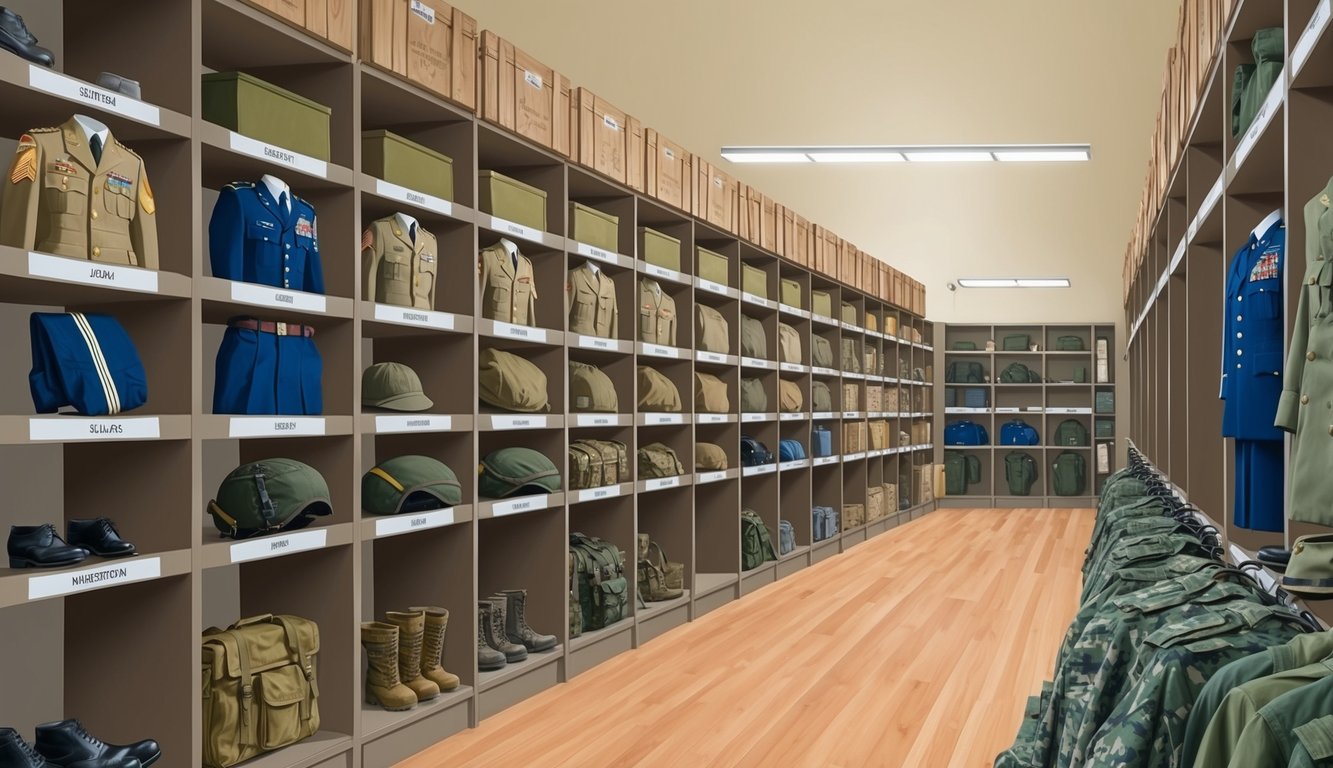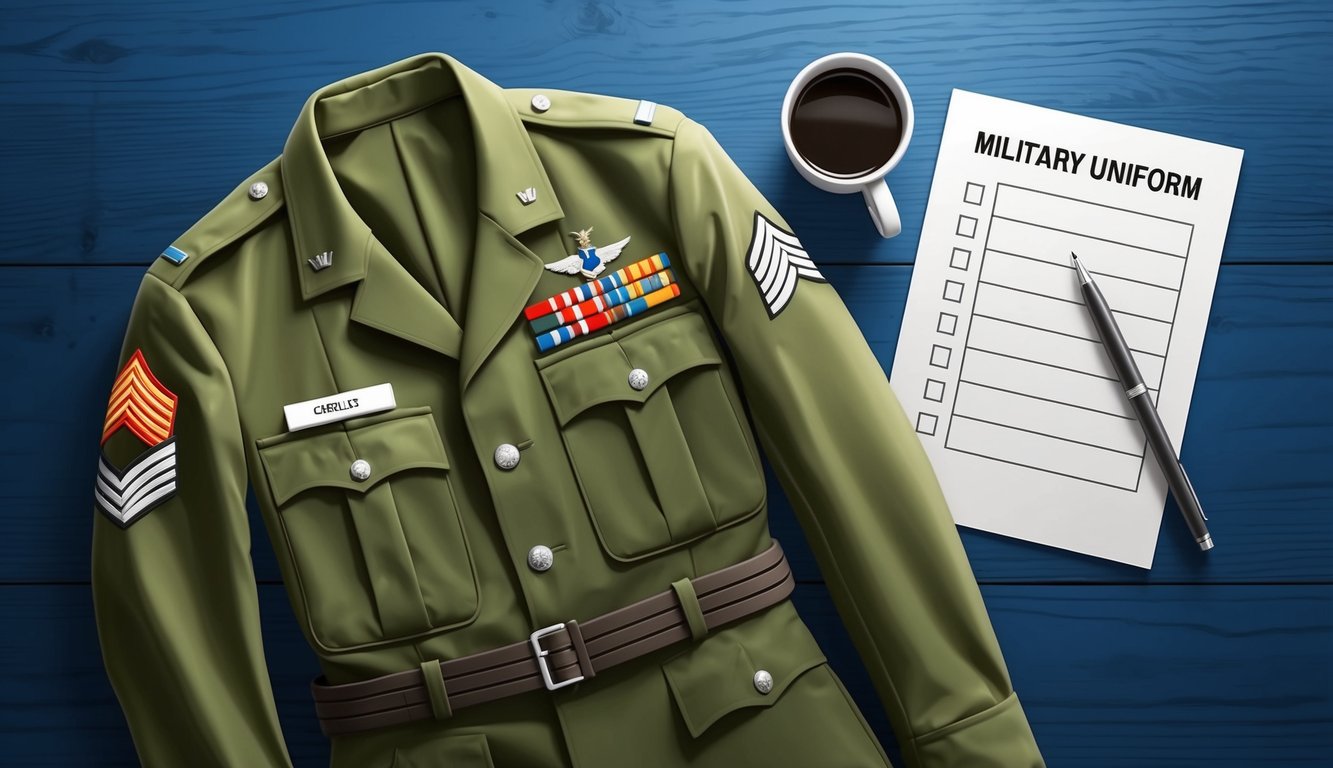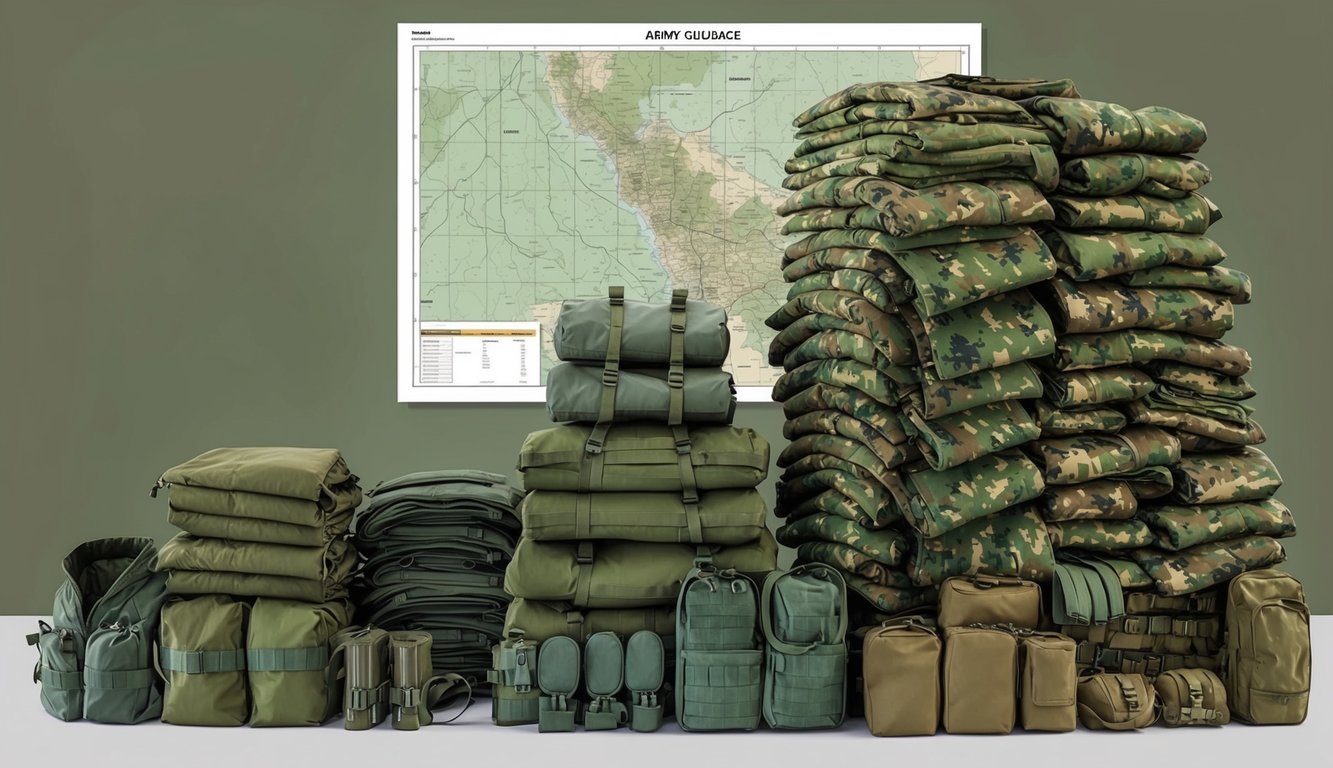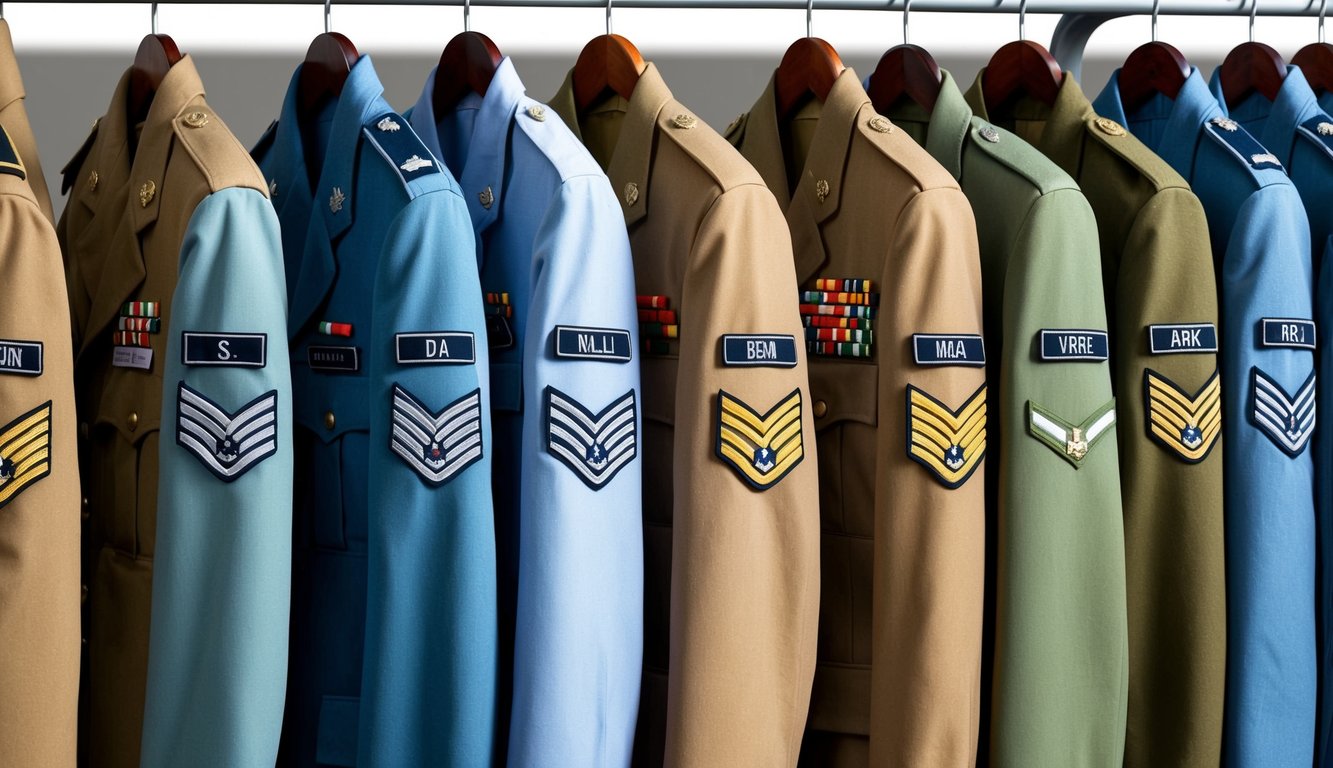Managing your Army clothing record plays a vital role in military life.
The Army Clothing Record is an online platform enabling soldiers to view, manage, and maintain their Organizational Clothing and Individual Equipment (OCIE).
You can access this record through the Army Knowledge Online (AKO) portal or the Integrated Sustainable Management (ISM) system.
Keeping your clothing record current is essential for several reasons: it ensures that you have the appropriate gear for your missions, helps you stay accountable for issued items, and simplifies the process of replacing damaged or lost equipment.
As we shift to digital systems, managing your clothing record has become more efficient and user-friendly.
To access your Army Clothing Record, you’ll need an active Common Access Card (CAC) and a Department of Defense ID number linked to your OCIE record.
After logging in, you can view your current inventory, check due dates for gear turn-in, and even schedule appointments for clothing issues at your local Central Issue Facility (CIF).
Key Takeaways
- Army Clothing Records are available online through AKO or ISM systems
- Regular maintenance of your clothing record ensures accountability for your gear
- Digital management systems have enhanced efficiency in Army clothing administration
History of Army Clothing
The U.S. Army’s uniform has evolved significantly since 1776.
Initially, soldiers wore whatever they could find—often their own civilian attire with a hint of military influence.
In the early 1800s, uniforms became more standardized.
Soldiers donned blue coats with varied colored facings to represent their branches.
Keeping these coats clean on the battlefield must have been quite a challenge!
The Civil War brought changes, with Union soldiers in navy blue jackets and light blue trousers.
Though quite different from today’s camouflage, it served its purpose.
During World War I, more practical field uniforms were introduced, with olive drab becoming the color of choice to help soldiers blend in with their environment.
In 1954, the Army introduced the Army Green uniform, popularly known as “Army Greens.” It took a few years before soldiers could purchase them at the Quartermaster store.
Today, soldiers wear a variety of uniforms appropriate for their duties, from combat fatigues to dress blues, showcasing a balance of tradition and practicality.
Understanding the Army Clothing Record
The Army Clothing Record is an essential document that tracks your issued gear and uniforms.
It serves as an inventory of your military attire and equipment, ensuring you’re equipped for your duties.
Purpose and Importance
Your Army Clothing Record keeps track of all the gear and uniforms issued to you, which is crucial for accountability.
It ensures you’re properly outfitted for your role, preventing the loss of government property and allowing you to swiftly identify items that need replacement or turn-in when changing units or departing from service.
This record also safeguards you from being charged for missing items that were not issued to you.
It protects you against potential disputes regarding the gear you’re responsible for.
Keep your record updated and secured, as it contains sensitive information.
Components of a Clothing Record
Your Army Clothing Record generally includes several key components:
- Personal Information: Your name, rank, and unit (excluding your full Social Security Number for privacy)
- Item List: A detailed inventory of all issued clothing and equipment
- Quantities: The number of each item issued to you
- Issue Dates: When each item was received
- Turn-in Dates: When items were returned or replaced
The record may exist digitally via systems like AKO (Army Knowledge Online) or in paper form.
Familiarize yourself with both formats, as you may encounter either based on your unit or situation.
Some items, such as the Army Service Uniform, are considered one-time issues, and your record will denote this special status for specific gear.
Management of Army Clothing

The U.S. Army has established a robust system for managing soldiers’ clothing and equipment, ensuring troops have the necessary gear while maintaining accountability and proper care of issued items.
Issuance and Tracking
Upon joining the Army, you will receive your initial uniform and equipment issue at the Central Issue Facility (CIF).
Your Clothing Record is generated in the Army’s electronic system, detailing every item issued to you.
This digital record monitors your Organizational Clothing and Individual Equipment (OCIE) throughout your service.
You can access your clothing record online via the “My Clothing Record” portal.
This feature allows you to view your current inventory and prepare for upcoming inspections or deployments, aiding in gear accountability and planning for necessary replacements.
Appointments at CIF can be scheduled to exchange worn items or obtain additional equipment for special assignments.
Always ensure your clothing record is up-to-date to avoid complications during transfers or separations.
Maintenance and Upkeep
Proper care of your Army-issued clothing and equipment is essential.
You’re responsible for cleaning, repairing, and maintaining your gear to military standards.
Frequent inspections ensure your items remain serviceable.
Routine minor repairs, such as sewing buttons or patching small tears, are typically your responsibility.
For more significant damage, a visit to the CIF may be required for repair or replacement.
Store your gear correctly to extend its lifespan.
Use issued bags or containers to protect items from dust and moisture, and follow care labels for washing uniforms to maintain their appearance and functionality.
If you lose or damage an item due to negligence, you might incur charges for its replacement.
Always report lost items promptly to update your clothing record and arrange for reissue if necessary.
Inventory Procedures

Regular inventory checks are vital for sustaining accurate clothing records in the U.S. Army.
These procedures ensure that your issued items are accounted for and in prime condition.
Routine Checks
You should perform routine checks of your clothing and equipment at least once a month.
Lay out all your issued items and compare them to your clothing record.
Inspect each piece for wear and tear, noting any items in need of repair or replacement.
Update your record when you receive new items or turn in old ones, and consider keeping a personal list of your gear as a backup.
This can be especially helpful during field exercises or deployments when items may go missing.
Reporting Discrepancies
If you detect any discrepancies during your inventory check, report them immediately.
Document missing items on a DA Form 4697 (Department of the Army Report of Survey).
Be ready to explain the circumstances surrounding the loss.
For damaged items, submit a Statement of Charges or Cash Collection Voucher.
Your unit supply sergeant can assist you in this process.
Remember that prompt reporting can avert larger issues down the road.
If you’re unsure about any part of the inventory process, don’t hesitate to seek assistance.
Your chain of command and unit supply personnel are available to help you maintain accurate records.
Modernization of Army Clothing Management

The U.S. Army is adopting digital solutions to enhance clothing management for soldiers.
New systems aim to improve efficiency and integrate with other military platforms.
Digitalization of Records
You will notice significant changes in how the Army manages clothing records.
Those days of paper forms and manual tracking are behind us.
The new digital system allows you to access your clothing record anytime, anywhere.
With just a few clicks, you can view your issued items and check due dates for replacements.
This innovation saves you time and reduces hassle when preparing for inspections or deployments.
The digital records also enable supply officers to manage inventory more effectively.
The system sends automatic notifications regarding upcoming clothing and equipment needs, ensuring you’re always properly outfitted for your mission.
Integration with Other Military Systems
Your digital clothing record is now part of a larger Army systems ecosystem.
This integration provides numerous advantages for you and your unit.
When you receive orders for a new assignment, the system automatically updates your clothing requirements based on your new location and role.
You’ll know precisely which additional items you need before your move.
The integrated system also links with training databases.
If you’re set for a specialized course, it will highlight any specific gear necessary for that training.
This seamless information flow helps you remain prepared for all aspects of your service.
Practical Tips for Soldiers

Maintaining your army clothing record is essential for your military career.
Effective management ensures you have the right gear and streamlines administrative processes.
Updating Personal Information
Keep your personal information current in your clothing record, checking for accuracy regularly.
Ensure that any changes in your name, address, or contact details are updated promptly.
You can access your clothing record through AKO 2.0.
Look for the “My Clothing Record” link under military resources.
If you can’t locate it, ask your unit’s admin staff for assistance.
Don’t overlook size updates.
As your body changes over time, accurate measurements ensure you receive gear that fits correctly.
Proper Handling of OCIE
Organizational Clothing and Individual Equipment (OCIE) is crucial to your gear.
Treat it with care.
Regularly clean and maintain your items to prolong their lifespan.
Keep track of all your issued OCIE.
Use a checklist or take photos to remember what you have, which will assist during inventories and gear turn-ins.
If an item becomes damaged or lost, report it without delay.
Avoid delaying the process; your unit has procedures for replacing items.
When not in use, store your OCIE correctly.
Place items in a cool, dry location to prevent mold and mildew, avoiding prolonged exposure to direct sunlight.
Location-Based Considerations for Army Clothing

The U.S. Army operates in diverse environments globally, necessitating that soldiers possess clothing suitable for various climates and terrains.
Your clothing record will indicate the specific items needed based on your duty location and deployment status.
Adapting to Varied Climates
Your Army clothing requirements will vary significantly based on your station.
In arctic regions, you’ll be issued heavy insulated jackets, thermal underwear, and specialized cold-weather boots to protect against frostbite and hypothermia.
For tropical climates, your clothing record will include lightweight, moisture-wicking uniforms and insect-repellent treated garments to fend off mosquitoes and other pests.
In desert environments, clothing that protects from intense sun and heat will be issued, including breathable fabrics, wide-brimmed hats, and UV-protective eyewear.
Deployment-Specific Clothing Needs
When deployed, your clothing record adjusts to meet mission requirements.
For combat zones, the Army provides body armor, flame-resistant uniforms, and camouflage suitable for the local landscape.
Peacekeeping missions may require both combat and dress uniforms.
Your clothing record will reflect this dual necessity, ensuring preparedness for various situations.
Specialized roles, such as mountain warfare or jungle operations, come with unique clothing items, such as high-altitude gear or waterproof boots designed for swampy conditions.
Prior to deployment, always verify your clothing record to ensure you have all necessary items suitable for your specific mission and location.
Field Guidance

Proper field guidance is essential for maintaining an accurate and up-to-date army clothing record while deployed.
Setting up a functional workspace and conducting maintenance while on the move are key areas to consider.
Setting Up a Functional Space
Select a dry, well-lit area for your clothing record management.
If possible, set up a folding table and chair.
Remember to bring essential supplies, such as pens, paper, and a laptop.
Organize your paperwork in waterproof folders or containers to shield against the elements.
Create a simple filing system using labeled dividers for various uniform categories.
Keep a checklist of essential items handy for quick reference.
Utilize a sturdy tent or shelter to protect your workspace from rain and wind.
If indoors, find a quiet corner away from high-traffic areas.
Adequate lighting is crucial, so consider bringing a portable lamp.
Establish a routine for updating records at your designated area to maintain consistency.
Maintenance on the Move
Create a mobile kit for on-the-go record updates.
Pack a weatherproof case with essential forms, writing tools, and a small notebook.
Use abbreviations and shorthand to quickly jot down changes in the field, and take photographs of new or damaged items with your smartphone for later documentation.
Whenever possible, create a digital backup of your records.
Utilize cloud storage or encrypted USB drives to protect your information.
Schedule periodic check-ins with your unit’s supply sergeant to synchronize records.
When relocating, pack your record-keeping materials last and unpack them first at the new site.
Establish a buddy system for double-checking entries and identifying discrepancies.
Teach others in your unit basic record-keeping skills as a contingency.
Remain adaptable and adjust your methods to the changing conditions of the field.
Conclusion
Keeping your Army clothing record updated is essential for your military career.
Regularly review and maintain this important document.
The U.S. Army provides resources to assist you in effectively managing your clothing record, including online portals and self-service options.
Ensure to review your record prior to essential events like inspections or deployments, ensuring you possess all necessary gear.
If you observe any discrepancies, reach out to your unit’s supply personnel.
They can help address issues and update your record as needed.
Being diligent about your clothing record reflects your attention to detail and readiness.
It’s a small yet significant aspect of your broader military responsibilities.
By taking charge of this administrative task, you’re contributing to both your unit’s preparedness and your professional growth within the Army.
Frequently Asked Questions
Accessing and managing your Army clothing record involves various online systems and processes.
Here are some common questions soldiers have regarding obtaining their gear records and CIF information.
How do I access my Army clothing record online?
You can access your Army clothing record via the Integrated Logistics Support (ISM) website.
Log in using your CAC card or DS Logon credentials.
Navigate to the “My Clothing Self Service” page to view your current OCIE record.
Which form lists individual equipment in the Army?
DA Form 3645 is the official Individual Clothing and Equipment Record.
This form details all organizational clothing and individual equipment (OCIE) provided to you by the Army.
What’s the process to obtain my CIF clothing record?
Visit your local Central Issue Facility (CIF) in person.
Bring your military ID and request a copy of your clothing record.
Additionally, you can access it online via the ISM website as mentioned earlier.
Can I find my Army OCIE record through the ISM website?
Yes, you can retrieve your OCIE record on the ISM website.
After logging in, look for the “Guest My Clothing Self Service” page, which displays your current issued equipment and clothing items.
What site replaced the Army AKO for managing clothing records?
The AKO Links website (https://www.akolinks.com) has taken over some functions previously managed by AKO.
You can access your OCIE record by logging in and selecting “My OCIE Record” from this site.
How can I get a copy of my issued gear from the Army?
Log into the ISM website or AKO Links.
Navigate to your clothing record page and click on “Sign & Print” to generate a printable version of your gear list.
Remember to sign and date the document before printing for official use.

